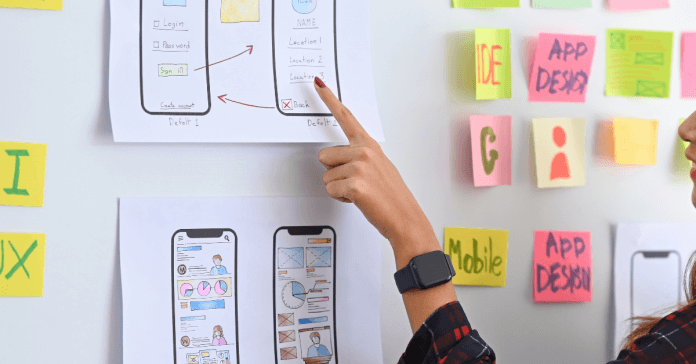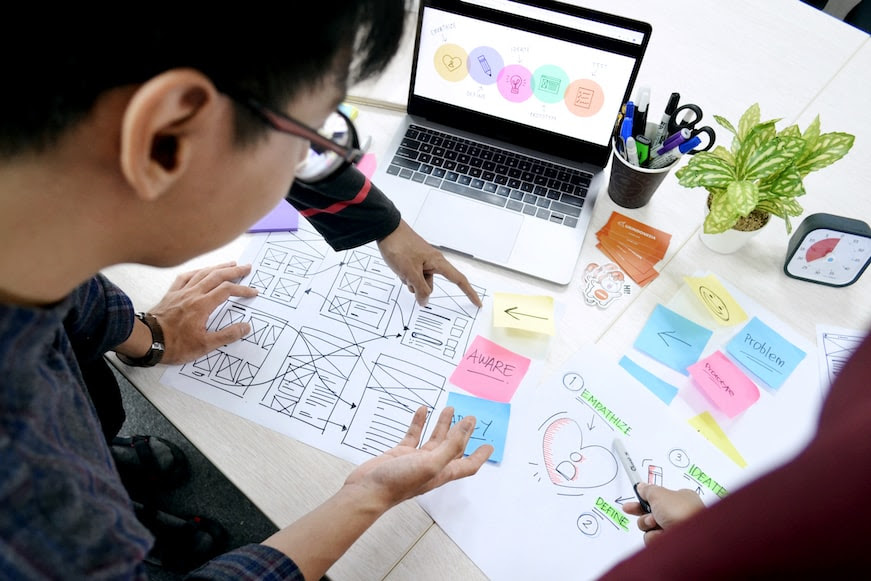A prototype plays an important role in UX design. Using a good prototype can test out how users will experience your product. It interacts with them before they commit to a layout. Their path towards a profitable software product will begin after testing those designs, keeping what works, and reworking what doesn’t. High-fidelity prototypes and low-fidelity prototypes are two types of software prototypes.
High-fidelity prototypes introduce UI elements and how the user will interact with the final design, while low-fidelity prototypes test information architecture and user flows.
Let’s discuss low-fidelity and high-fidelity prototypes- when should we use them and what to look for?
What do you Understand by Prototype?
A prototype simulates interaction and user flow by using wireframes and mockups. Developing prototypes is an excellent way for designers to get feedback from key stakeholders and end-users.
The feedback is then used to modify and improve the design, optimizing the User Experience (UX) before it is passed on to the coders. Prototyping goals, design completeness, and resources are taken into consideration when choosing a prototype’s fidelity.
As far as accuracy is concerned, it refers to how accurately a prototype conveys the final product’s appearance depending on-
- Visual design (element shapes and visual hierarchy)
- Interactivity
- Content
What is Low-Fidelity Prototype?
Prototypes with low fidelity are used to test user flows and information presentation. Low-fidelity prototypes can be very simple – for example, a hand-drawn prototype without colors or content- or more detailed, depending on the project. Low-fidelity prototypes help visualize layouts, test user flows, and test navigational experiences.
Paper prototyping and clickable prototype wireframe are the two popular examples of low-fidelity prototyping, that we will discuss below:
1. Paper Prototyping
A paper prototype is simply the simplest, lowest-fidelity prototype you could possibly imagine, and it’s exactly what you’d expect. Designers can sketch wireframes on paper and emulate what will appear on the screen instead of pumping out basic graphics for display on a monitor or smartphone. A usability test subject engages with a paper document similar to an actual software application by following a set of instructions. The benefit is that it is quick and easy to design, however, the downside is that the test subject must use a lot of imagination, and the results might not be as accurate.
2. Clickable Wireframes
A clickable wireframe can be used to test user interface usability when it comes to low-fidelity prototyping. Wireframes are a general representation of the layout of an application, and they are interactive due to their “clickable” nature. Wireframes are clickable, but in contrast to paper prototyping, users can jump to different screens by pressing buttons. It takes more time and skill to create clickable prototype wireframes than paper wireframes, which are less skill-based.
Do you think that a low-fidelity prototype is a right start for your digital product development journey?
Want to build a low-fidelity prototype for your startup? By reading this guide you will get to know how low-fidelity prototypes make a difference for your mobile app.
Benefits of Low-fidelity prototypes
- It is inexpensive to create low-fidelity prototypes, which means teams can test multiple variations and iterations quickly and affordably.
- Creating low-fidelity prototypes is easy since they only consist of simple lines and shapes- even non-design team members can contribute valuable ideas.
- It is possible for designers to make low-fidelity prototypes very quickly. During testing or meetings, designers can make quick changes to visualize fresh ideas.
Disadvantages of Low-fidelity prototypes
- A low-fidelity prototype does not provide accurate results during testing since it has a basic layout and functionality.
- Low-fidelity prototypes can be dull and disappointing without color, interaction, transitions, or animations.
When should you use low-fidelity prototypes?
With your understanding of low-fidelity prototyping, we can begin exploring when you would use one.
Low-fidelity prototypes are ideal for early design stages. A low-fidelity prototype is particularly helpful for UX designers when they are just beginning iterations, as it makes collaboration with other designers easier while committing the least amount of time to sketch and modify the initial concepts.
It is great to use low-fidelity prototypes to brainstorm ideas with the client and demonstrate concepts to developers and stakeholders. You can also use them to conduct early user testing for your product.
Use Low-fidelity prototypes when:
- You want to understand the scope of your project quickly,
- You want to test your idea before you start developing it,
- The idea is kept within the product team.
Choosing the right team to build the UI and UX of your product is challenging if you are a novice in this field. Well, if that is the case, this guide on app design best practices can be super helpful to cross-verify the process your team is going to follow.
What is a High-Fidelity prototype?
Creating a high-fidelity prototype allows you to better understand how users may interact with various elements and what the final layout looks like. In a high-fidelity prototype, details are much more refined – this is the point at which the final product is formed. In high-fidelity prototypes, color and content are represented equally, and the final product will function and look almost exactly the same as the mockup.
The user experience can now be enhanced by adding interactions, transitions, and animations. Whenever a design team is presenting its concept to conduct a usability study, high-fidelity prototypes are the best option.
Digital prototypes and coded prototypes are two examples of high-fidelity prototypes! Let’s find out more about both of these types of prototypes below.
Do you want to develop a high-fidelity prototype for your mobile app project? Our mobile app design agency is here to build immersive high-fidelity prototypes.
1. Digital Prototypes
In digital prototypes, designers are allowed to create detailed imitations of the final product, resulting in aesthetically pleasing and interactive prototypes. Product teams get valuable feedback on their product design from designers before going ahead and launching their final version.
2. Coded Prototypes
Coded prototypes are the most realistic representations of the final product, in terms of how it looks and behaves. Therefore, they’re useful if you’d like to get some feedback from users before releasing a product.
Benefits of High-fidelity prototypes
- It is important to create high-fidelity prototypes in usability studies so that participants are able to interact with the prototype in the same way they would interact with the final product.
- The high-fidelity prototype provides stakeholders with a better understanding of the final product. Creating prototypes like these could be helpful for startups seeking funding or for pitching clients on product concepts.
- The high-fidelity prototype features enable you to test specific interactions such as animated transitions and other micro-interactions.
Disadvantages of High-fidelity prototypes
- In the absence of clear objectives, UX designers may become distracted when creating high-fidelity prototypes.
- It costs more money to produce high-fidelity prototypes because designers have to spend time refining graphics and copywriters have to spend time tweaking microcopy and content.
Do you want to avoid spending tons of money on building an app that won’t fulfill your business objectives? You can read our brief article on critical mistakes to avoid while initiating a mobile UI design.
When should you use high-fidelity prototypes?
Our next step is to understand when should you use high-fidelity prototyping.
UX designers will need to spend time adding elements, color, content, and clickable links.
The high-fidelity prototypes make them look and work like the end product as much as possible. In high-fidelity prototypes, transitions and other interactions are not usually included until usability studies have been conducted.
UX designers should use high-fidelity prototypes as the final stage of high-fidelity prototyping in order to understand how user movements, such as scrolling, affect content and elements. Creating high-fidelity prototypes should be the last step before handing them over to engineers.
Use high-fidelity prototypes when you:
- Want to start developing before making a final decision,
- Have tested and approved a low-fidelity prototype,
- Ready to upgrade your low-fidelity prototype,
- Pitch your idea to someone who is not a tech expert.
Final words
Prototypes are essential for designers during UX testing because they allow them to refine their efforts as early as possible.
It would be a waste of time and resources to implement a design that fails when the users start interacting with it without prototyping. It would then be up to the software creators to decide: Do they want to spend more time and money redesigning the software, or do they want to market an inferior product?
Prototyping at all levels, from low-fidelity to high-fidelity, plays an important role in the design of products that can dominate their markets.
Still not sure where to start? Hire a mobile apps development team singapore to build a market-fit mobile app.









